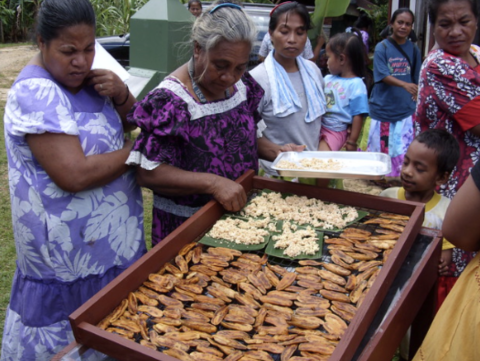Micronesian women process local crops into flour products
Micronesian women process local crops into flour products
In Micronesia, Emihner Johnson promotes new local flour made from indigenous crops, aiming to reduce reliance on imported food and combat climate change while empowering women economically. This story is part of a series celebrating the locally-led solutions supported by the UNDP implemented - Adaptation Fund Climate Innovation Accelerator programme.
Emihner Johnson is planning a recipe contest to grab the attention of restaurants, shops and the public in Pohnpei.
She wants to showcase new flour products milled from indigenous crops like banana, taro, bread fruit and tapioca, by women who live an hour or two away by boat, in Chuuk.
Pohnpei and Chuuk are two of the four federated states of Micronesia, a country comprising over 600 islands across the western Pacific ocean.
Nearly 100% of the country’s food is imported with a heavy carbon footprint, including wheat flour.
That’s one of the reasons why, for several years now, Johnson and the Island Food Community of Pohnpei (IFCP) have been saying “let’s go local” instead.
She says there are many climate, health and economic benefits to processing traditional home-grown crops into versatile flours that have a long shelf-life.
Firstly, IFCP commissioned scientific analyses that show the flours are far more nutritious than the wheat flour most people buy today.
Johnson says that traditionally, people would harvest, boil and eat indigenous crops immediately to avoid spoiling, with much of it going to waste.
“We fry them, we chop them, we bake them in different dishes. But it has to be eaten in one or two days,” says Johnson.
By sun-drying and milling what’s left over, the crops gain a longer shelf-life. It is also an opportunity for people to package, transport and sell it as a product for extra income to ensure food security.
Food security in Micronesia, like almost everywhere else, is also being negatively impacted by climate change.
In the case of taro crops, for instance, rising sea levels and higher tides cause more salt water intrusion into the swamps where they grow.
“Once it goes in the taro, you cannot eat the taro the traditional way; the only way we’ve been eating it. It’s so spongy. It’s so sour like you’re eating … something that is not food.”
But by milling the spongy tarot, it is possible to turn it into edible flour, says Johnson. “We’re turning that damage into good. Because we’ve tasted it; we can eat the flour.”
The flour is milled using a machine that IFCP procured for Women’s Council of Chuuk using money from the Adaptation Fund and European Union, which supports climate innovation in developing countries through its UNDP-Adaptation Fund Climate Innovation Accelerator (AFCIA) programme.
Johnson says the women using the machine are “very very poor”. When they first brought the machine and demonstrated how it works, the women could hardly believe how much time it would save, she says.
A task that would usually take them four hours by hand now takes just five minutes. “Their eyes were so big, right? Some women cried,” says Johnson.

Johnson says they are still working on training the women around packaging, but they want to raise awareness about the flour products among potential buyers, particularly in Pohnpei.
“The capital [Palikir] has the restaurants and markets, so these are the business communities I want to attract … so that the women can earn some money if they have surplus,” she says.
“And also those that don’t farm can have access to local healthy foods.”
She says this project, from the entire island communities’ perspective, is something very sustainable. It is for anyone who grew up on these islands, she says, whether or not they have money.
“The environment is right there. Just give them the right tools to help them to go somewhere.”
At the recipe contest in Pohnpei, the winners will receive prizes and the public will be able to taste test the recipes.
Johnson hopes that at least one dish will make it onto the menu of a restaurant. “It might be a baby step, but it’s a big deal for us.”
About this article
This story has been co-created with the support of IFCP, UNDP, CDKN, ICCCAD, and GRP, under the framework of the UNDP-managed Adaptation Fund Climate Innovation Accelerator (AFCIA).
The UNDP-AFCIA programme counts on financial contributions from the Adaptation Fund and the European Union and has awarded 44 micro and small grants to locally-led organisations across 33 countries worldwide, accelerating their innovative solutions to build resilience in the most vulnerable communities.
UNDP-AFCIA, is one of the funding windows anchored under the Adaptation Innovation Marketplace (AIM), a multi-stakeholder strategic platform that promotes scaled-up adaptation at the local level, launched by UNDP Administrator Achim Steiner at the Climate Adaptation Summit in January 2021.
